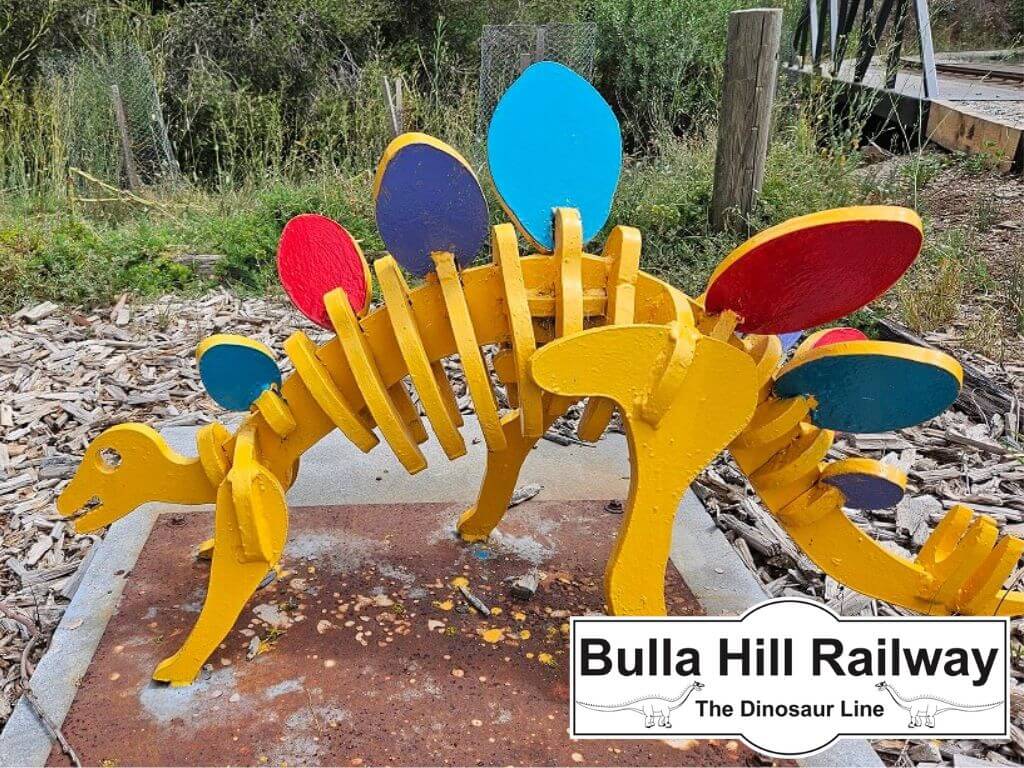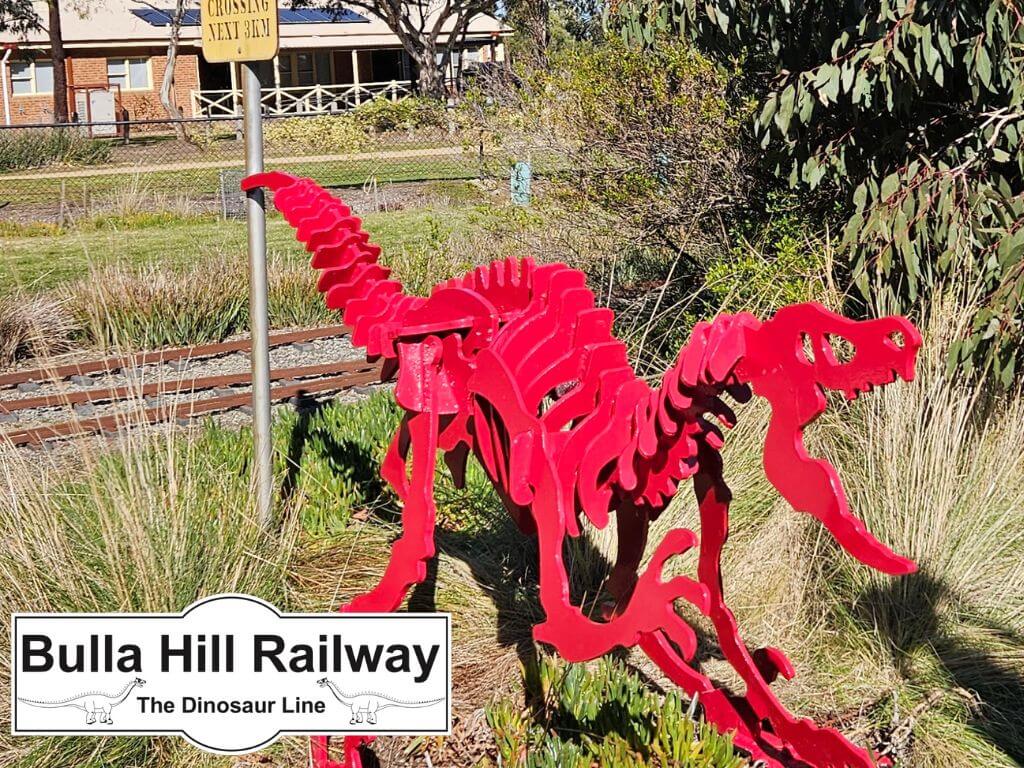Open 3rd Sunday of Every Month ONLY
Meet Our Dinosaurs
- Allosaurus Fragilis
- Brachiosaurus
- Diplodocus
- Stegosaurus x 2
- Triceratops x 2
- T-Rex
- Velociraptor
🎉 Take the Dinosaurs Home! 🦖🦕
Hey kids — want your own Dino Facts Sheet to keep and explore? 📝
Just click the button below and grab your very own Jurassic adventure! 🌋✨
2026 RUN DAYS
JANUARY 18TH
TWILIGHT RUN
FEBRUARY 15TH
MARCH 15TH
APRIL 19TH
MAY 17TH
JUNE 21ST
JULY 19TH
AUGUST 16TH
SEPTEMBER 20TH
OCTOBER 18TH
NOVEMBER 15TH
DECEMBER 20TH

Tyrannosaurus Rex 👑🦖
Meet the Tyrannosaurus Rex — the king of the dinosaurs! 👑🦖 Imagine the biggest, scariest dinosaur ever, with huge sharp teeth, a massive head, tiny but powerful arms, and a tail that could balance its whole body. T-Rex was the ultimate dinosaur adventure — fierce, fast, and totally awesome!
Its name comes from Greek and Latin: “Tyrannosaurus” means “tyrant lizard,” and “rex” means king — perfect for this dinosaur ruler!
T-Rex lived in what is now western North America, roaming around during the late Cretaceous Period, about 66 million years ago. It walked on two legs, using its long, heavy tail to balance its giant head.
This dinosaur was huge — up to 13 metres (42 ft) long, 4 metres (13 ft) tall at the hip, and weighing up to 7 tons! Its skull alone could measure 1.5 metres (5 ft), and its teeth were gigantic — the largest carnivorous dinosaur teeth ever found, about 30 cm (1 ft) long! 🦷
T-Rex could grow really fast as a teenager, putting on about 600 kg (1,300 lbs) a year for 4 years. Its tiny arms may have looked useless, but they were super strong with two clawed fingers!
Scientists debate whether T-Rex was a hunter or a scavenger, but one thing’s for sure — its forward-facing eyes gave it awesome depth perception, perfect for spotting prey or dinner from far away. Estimates suggest it could run up to around 40 km/h (25 mph) — fast enough to catch some unlucky dinosaurs! ⚡
With its giant teeth, massive size, and roar-worthy reputation, T-Rex isn’t just scary — it’s legendary, and kids everywhere love imagining this ultimate dinosaur king in action! 😲

Allosaurus Fragilis — the Jurassic Beast! 🦖
Think T-Rex, but even cooler (and a little less famous)! Allosaurus was a mega meat-eater, hunting other dinosaurs with its huge, sharp teeth and super-strong claws. Imagine a lightning-fast, muscle-packed predator stalking its prey — that’s Allosaurus!
This fierce hunter roamed the Earth around 150 million years ago during the late Jurassic Period. Its name, Allosaurus, means “different lizard” — and it truly was one-of-a-kind. Most fossils have been found in the Morrison Formation in the western United States.
Allosaurus had a big skull, long tail, and walked on two legs. Its short arms each had three claws perfect for grabbing dinner. On average, it grew 8.5 metres long (about 28 feet!) and weighed 2.3 tons — that’s as heavy as a small car!
This dinosaur was a top predator and wasn’t afraid to take on even tough targets like Stegosaurus. With its sharp, saw-edged teeth and incredible speed, Allosaurus Fragilis was one of the fiercest hunters of the Jurassic world!

Brachiosaurus 🌳🦕
Meet Brachiosaurus — the dinosaur with a neck so long it could touch the sky! 🌳🦕 Imagine a gentle giant towering above the trees, munching on the juiciest leaves way up high. It’s like the skyscraper of the dinosaur world!
Brachiosaurus was huge — one of the biggest dinosaurs ever — and that super-long neck helped it reach the yummiest leaves that no other dinosaur could get. Can you imagine seeing a dinosaur that tall strolling by? 😲
The Brachiosaurus is a type of Sauropod, famous for growing to incredible sizes. Its relatives include other massive dinosaurs like Diplodocus and Apatosaurus.
Its name comes from Greek words meaning “arm” and “lizard” because its front legs were longer than its back legs — pretty unusual for a dinosaur!
This gentle giant had a long neck, a small head, and a shorter tail compared to its Sauropod cousins. It walked on all four legs and could weigh between 30 and 45 tons — that’s as heavy as 6 elephants! 🐘🐘🐘
Brachiosaurus could grow up to 26 metres (85 feet) long — longer than a basketball court! Its super-long neck let it reach leaves way up high, and it needed to eat 200–400 kilograms (440–880 pounds) of plants every single day. Talk about a hungry dinosaur! 🌿
And here’s a cool space fact: there’s even an asteroid named after Brachiosaurus in our Solar System! 🌌
Brachiosaurus wasn’t just big — it was epic, sky-high, leaf-munching amazing! Can you imagine seeing one strolling through the trees? WOW! 😲

Diplodocus 🦕
Meet Diplodocus — a super long, long-necked dinosaur that’s like a giant version of a lizard! 🦕 Its neck and tail were extra-long, and it walked on all four legs. It wasn’t as tall as Brachiosaurus, but it was still huge, and a true gentle giant of the dinosaur world.
Imagine a massive dinosaur slowly strolling through the forests, munching on leaves all day long 🌿 — that’s Diplodocus! It was a peaceful plant-eater that lived around 150 million years ago in what’s now western North America.
Its name comes from Greek words meaning “double beam”, which refers to the unusual shape of the bones in its tail — isn’t that cool? Its tail alone had around 80 vertebrae, making it super long and flexible.
Diplodocus is a famous dinosaur — you’ll see it in films, documentaries, toys, and museums all over the world. Because scientists have found lots of its fossils, they know a lot about how this dinosaur lived.
It could grow up to 35 metres (115 feet) long and weigh 10–15 tons — as big as a small herd of elephants! 🐘🐘
Some early researchers thought Diplodocus might have swum in water, but scientists now know that its chest would have made it too hard to breathe underwater, so it stayed safely on land.
Diplodocus wasn’t just big — it was super long, leaf-munching, tail-swinging amazing! Imagine seeing one walking by… 😲

Small Triceratops – The Mini Horned Hero! 🦖🌿
The small Triceratops might have been a bit smaller than its giant cousin, but it was still a three-horned hero of the dinosaur world! With a horned face and a bony frill around its neck like a natural shield, it could protect itself while munching on leaves and bushes 🌱.
Don’t be fooled — even small, it was a gentle giant, happily grazing and roaming in groups for safety. Its name comes from Greek: “tri” = three and “keratops” = horned face — perfect for this little prehistoric warrior!
The first Triceratops fossils were discovered in 1887 near Denver, Colorado, and since then, this dinosaur has appeared in movies, toys, and even Transformers as the Autobot Slag! ⚡

Large Triceratops – The Giant Horned Tank! 🦖💥
The large Triceratops was a true prehistoric powerhouse. Growing up to 8 metres long, 3 metres tall, and weighing 6–12 tons — as heavy as a small herd of elephants! 🐘 — this giant had three massive horns and a huge frill to defend itself from predators like Tyrannosaurus Rex.
Its skull alone could reach over 2 metres (7 ft) long, with 400–800 teeth that kept replacing themselves so it could chew endless plants. Despite its enormous size, it was still a plant-loving gentle giant 🌿, roaming the late Cretaceous forests with its herd.
From its first fossils found in 1887 near Denver, Colorado, to starring in films, toys, and Transformers as Slag, the large Triceratops has captured imaginations for generations. Truly a prehistoric superhero! 😲🌟

Small Stegosaurus – The Spiky Little Plant-Eater! 🦕🌿
The small Stegosaurus might have been smaller than its giant relatives, but it was still a prehistoric marvel! With two rows of bony plates along its back and a spiky tail for protection, it was ready to defend itself while munching on ferns and leaves 🌱.
Its name comes from Greek: “stego” = roof and “saurus” = lizard, because those plates looked like a roof on its back. Despite its spiky armor, this little dinosaur was a gentle plant-eater, wandering in herds for safety and keeping an eye out for predators.
Small Stegosaurus fossils were first discovered in the late 19th century, and this dinosaur has inspired movies, toys, and books, making it a favorite among dinosaur fans everywhere! ⚡

Large Stegosaurus – The Giant Spiky Wonder! 🦕💥
The large Stegosaurus was one of the most fascinating giants of the Jurassic Period. Growing up to 9 metres (30 ft) long and 4 metres (13 ft) tall, it had massive bony plates along its back and a tail tipped with long spikes, perfect for defending against hungry predators like Allosaurus!
Its spiky tail, nicknamed the thagomizer, could deliver a powerful swing, while its plates might have helped regulate body temperature or even show off to other Stegosaurus. Despite looking armored and tough, it was a slow-moving, plant-loving giant, enjoying ferns, cycads, and other leafy snacks 🌿.
First fossils were discovered in the late 1800s in North America, and the large Stegosaurus has since become a dinosaur superstar, appearing in films, toys, museums, and books — a true Jurassic hero! 😲🌟

Velociraptor ⚡🦖
Meet the Velociraptor — the ninja of the dinosaur world! 🦖💨 Small, fast, and super clever, Velociraptors were like the ultimate dinosaur team players. Picture a feathery lizard with a long tail, sharp claws, and a pointy snout, hunting in packs and outsmarting dinosaurs much bigger than themselves!
The name Velociraptor means “swift seizer” — and boy, could they seize their prey! Even though they were about the size of a turkey, these little dinos were smart, speedy, and fearless. They probably had feathers, which helped them stay agile while chasing their meals.
Velociraptors lived during the late Cretaceous Period, around 73 million years ago, and one of the most famous fossils shows a Velociraptor locked in battle with a Protoceratops! 🥊
A fully grown Velociraptor could be up to 2 metres (6.6 ft) long, 0.5 metres (1.6 ft) tall at the hip, and weigh up to 15 kg (33 lbs). They used their sickle-shaped claws on their feet to catch and hold prey — tiny but terrifying!
Even though movies like Jurassic Park made them look huge, the real Velociraptor was small, feathered, and lightning-fast, making it one of the coolest and smartest dinosaurs ever. ⚡
